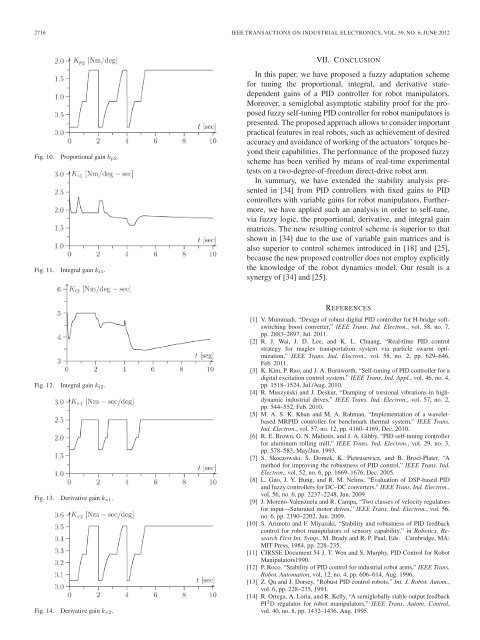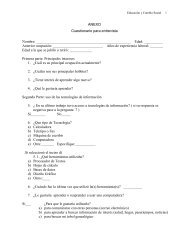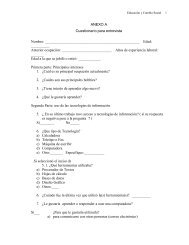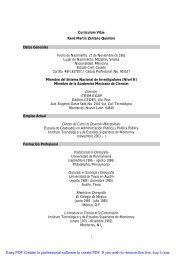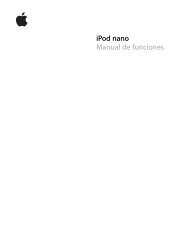2716 IEEE TRANSACTIONS ON INDUSTRIAL ELECTRONICS, VOL. 59, NO. 6, JUNE 2012VII. CONCLUSIONFig. 10. Proportional gain k p2 .Fig. 11. Integral gain k i1 .In this paper, we have proposed a fuzzy adaptation scheme<strong>for</strong> tuning the proportional, integral, and derivative statedependentgains of a <strong>PID</strong> controller <strong>for</strong> robot manipulators.Moreover, a semiglobal asymptotic stability proof <strong>for</strong> the proposedfuzzy self-tuning <strong>PID</strong> controller <strong>for</strong> robot manipulators ispresented. The proposed approach allows to consider importantpractical features in real robots, such as achievement of desiredaccuracy and avoidance of working of the actuators’ torques beyondtheir capabilities. The per<strong>for</strong>mance of the proposed fuzzyscheme has been verified by means of real-time experimentaltests on a two-degree-of-freedom direct-drive robot arm.In summary, we have extended the stability analysis presentedin [34] from <strong>PID</strong> controllers with fixed gains to <strong>PID</strong>controllers with variable gains <strong>for</strong> robot manipulators. Furthermore,we have applied such an analysis in order to self-tune,via fuzzy logic, the proportional, derivative, and integral gainmatrices. The new resulting control scheme is superior to thatshown in [34] due to the use of variable gain matrices and isalso superior to control schemes introduced in [18] and [25],because the new proposed controller does not employ explicitlythe knowledge of the robot dynamics model. Our result is asynergy of [34] and [25].Fig. 12. Integral gain k i2 .Fig. 13. Derivative gain k v1 .Fig. 14. Derivative gain k v2 .REFERENCES[1] V. Mummadi, “Design of robust digital <strong>PID</strong> controller <strong>for</strong> H-bridge softswitchingboost converter,” IEEE Trans. Ind. Electron., vol. 58, no. 7,pp. 2883–2897, Jul. 2011.[2] R. J. Wai, J. D. Lee, and K. L. Chuang, “Real-time <strong>PID</strong> controlstrategy <strong>for</strong> maglev transportation system via particle swarm optimization,”IEEE Trans. Ind. Electron., vol. 58, no. 2, pp. 629–646,Feb. 2011.[3] K. Kim, P. Rao, and J. A. Burnworth, “<strong>Self</strong>-tuning of <strong>PID</strong> controller <strong>for</strong> adigital excitation control system,” IEEE Trans. Ind. Appl., vol. 46, no. 4,pp. 1518–1524, Jul./Aug. 2010.[4] R. Muszynski and J. Deskur, “Damping of torsional vibrations in highdynamicindustrial drives,” IEEE Trans. Ind. Electron., vol. 57, no. 2,pp. 544–552, Feb. 2010.[5] M. A. S. K. Khan and M. A. Rahman, “Implementation of a waveletbasedMR<strong>PID</strong> controller <strong>for</strong> benchmark thermal system,” IEEE Trans.Ind. Electron., vol. 57, no. 12, pp. 4160–4169, Dec. 2010.[6] R. E. Brown, G. N. Maliotis, and J. A. Gibby, “<strong>PID</strong> self-tuning controller<strong>for</strong> aluminum rolling mill,” IEEE Trans. Ind. Electron., vol. 29, no. 3,pp. 578–583, May/Jun. 1993.[7] S. Skoczowski, S. Domek, K. Pietrusewicz, and B. Broel-Plater, “Amethod <strong>for</strong> improving the robustness of <strong>PID</strong> control,” IEEE Trans. Ind.Electron., vol. 52, no. 6, pp. 1669–1676, Dec. 2005.[8] L. Guo, J. Y. Hung, and R. M. Nelms, “Evaluation of DSP-based <strong>PID</strong>and fuzzy controllers <strong>for</strong> DC–DC converters,” IEEE Trans. Ind. Electron.,vol. 56, no. 6, pp. 2237–2248, Jun. 2009.[9] J. Moreno-Valenzuela and R. Campa, “Two classes of velocity regulators<strong>for</strong> input—Saturated motor drives,” IEEE Trans. Ind. Electron., vol. 56,no. 6, pp. 2190–2202, Jun. 2009.[10] S. Arimoto and F. Miyazaki, “Stability and robustness of <strong>PID</strong> feedbackcontrol <strong>for</strong> robot manipulators of sensory capability,” in Robotics. ResearchFirst Int. Symp., M. Brady and R. P. Paul, Eds. Cambridge, MA:MIT Press, 1984, pp. 228–235.[11] CIRSSE Document 54 J. T. Wen and S. Murphy, <strong>PID</strong> Control <strong>for</strong> RobotManipulators1990.[12] P. Roco, “Stability of <strong>PID</strong> control <strong>for</strong> industrial robot arms,” IEEE Trans.Robot. Automation, vol. 12, no. 4, pp. 606–614, Aug. 1996.[13] Z. Qu and J. Dorsey, “Robust <strong>PID</strong> control robots,” Int. J. Robot. Autom.,vol. 6, pp. 228–235, 1991.[14] R. Ortega, A. Loria, and R. Kelly, “A semiglobally stable output feedbackPI 2 D regulator <strong>for</strong> robot manipulators,” IEEE Trans. Autom. Control,vol. 40, no. 8, pp. 1432–1436, Aug. 1995.
MEZA et al.: FUZZY SELF-TUNING <strong>PID</strong> SEMIGLOBAL REGULATOR FOR ROBOT MANIPULATORS 2717[15] J. Alvarez, I. Cervantes, and R. Kelly, “<strong>PID</strong> regulation of robot manipulators:Stability and per<strong>for</strong>mance,” Syst. Control Lett., vol. 41, no. 2,pp. 73–83, Oct. 2000.[16] S. Arimoto, Control Theory of Non-Linear Mechanical Systems: APassivity-Based and Circuit-Theoretic Approach. London, U.K.: Ox<strong>for</strong>dUniv. Press, 1996.[17] J. L. Meza, V. Santibañez, and R. Campa, “An estimate of the domain ofattraction <strong>for</strong> the <strong>PID</strong> regulator of manipulators,” Int. J. Robot. Autom.,vol. 22, no. 3, pp. 187–195, Jun. 2007.[18] R. Kelly, R. Haber, R. E. Haber, and F. Reyes, “Lyapunov stable controlof robot manipulators: A fuzzy self-tuning procedure,” Intell. Autom. SoftComput., vol. 5, no. 4, pp. 313–326, 1999.[19] S. Cong and Y. Liang, “<strong>PID</strong>-like neural network nonlinear adaptive control<strong>for</strong> uncertain multivariable motion control systems,” IEEE Trans. Ind.Electron., vol. 56, no. 10, pp. 3872–3879, Oct. 2009.[20] L. Mostefai, M. Denai, O. Sehoon, and Y. Hori, “Optimal control design<strong>for</strong> robust fuzzy friction compensation in a robot joint,” IEEE Trans. Ind.Electron., vol. 56, no. 10, pp. 3832–3839, Oct. 2009.[21] F.-J. Lin and P.-H. Chou, “Adaptive control of two-axis motion controlsystem using interval type-2 fuzzy neural network,” IEEE Trans. Ind.Electron., vol. 56, no. 1, pp. 178–193, Jan. 2009.[22] J. C. Shen, “<strong>Fuzzy</strong> neural networks <strong>for</strong> tuning <strong>PID</strong> controller <strong>for</strong> plantswith underdamped responses,” IEEE Trans. <strong>Fuzzy</strong> Syst., vol. 9, no. 2,pp. 333–342, Apr. 2001.[23] C. H. Tsai, C. H. Wang, and W. S. Lin, “Robust fuzzy model-followingcontrol of robot manipulators,” IEEE Trans. <strong>Fuzzy</strong> Syst., vol. 8, no. 4,pp. 462–469, Aug. 2000.[24] H. B. Kazemian, “The SOF-<strong>PID</strong> controller <strong>for</strong> the control of a MIMOrobot arm,” IEEE Trans. <strong>Fuzzy</strong> Syst., vol. 10, no. 4, pp. 523–532,Aug. 2002.[25] M. A. Llama, R. Kelly, and V. Santibañez, “A stable motion control system<strong>for</strong> manipulators via fuzzy self-tuning,” <strong>Fuzzy</strong> Sets Syst., vol. 124, no. 2,pp. 133–154, 2001.[26] J. L. Meza, V. Santibáñez, R. Soto, and M. A. Llama, “Stable fuzzy selftuning<strong>PID</strong> control of robot manipulators,” in Proc. IEEE Int. Conf. Syst.Man Cybern., San Antonio, TX, Oct. 2009, pp. 2698–2703.[27] M. Spong, S. Hutchinson, and M. Vidyasagar, Robot Modeling andControl. Hoboken, NJ: Wiley, 2006.[28] D. Koditschek, “Natural motion <strong>for</strong> robot arms,” in Proc. IEEE Conf.Decision Control, Las Vegas, NV, 1984, pp. 733–735.[29] P. Tomei, “Adaptive PD controller <strong>for</strong> robot manipulators,” IEEE Trans.Robot. Autom., vol. 7, no. 4, pp. 565–570, Aug. 1991.[30] R. Kelly and R. Carelli, “A class of nonlinear PD-type controllers <strong>for</strong>robot manipulators,” J. Robot. Syst., vol. 13, no. 12, pp. 793–802,Dec. 1996.[31] R. Kelly, V. Santibañez, and A. Loria, Control of Robot Manipulators inJoint Space. New York: Springer-Verlag, 2005.[32] H. K. Khalil, Nonlinear Systems, 3rd ed. Englewood Cliffs, NJ: Prentice-Hall, 2002.[33] R. Ortega, A. Loría, P. Nicklasson, and H. Sira-Ramirez, Passivity-BasedControl of Euler–Lagrange Systems. New York: Springer-Verlag, 1998.[34] V. M. Hernandez-Guzman, V. Santibañez, and R. Silva-Ortigoza, “A newtuning procedure <strong>for</strong> <strong>PID</strong> control of rigid robots,” Adv. Robot., vol. 22,no. 9, pp. 1007–1023, 2008.[35] L.-X. Wang, A Course in <strong>Fuzzy</strong> Systems and Control. Englewood Cliffs,NJ: Prentice-Hall, 1997.[36] F. Reyes and R. Kelly, “Experimental evaluation of model-basedcontrollers on a direct-drive robot arm,” Mechatronics, vol. 11, no. 3,pp. 267–282, Apr. 2001.J. L. Meza was born in Torreon, Coahuila, Mexico.He received the M.S. and Ph.D. degrees in electricalengineering from Instituto Tecnológico de la Laguna,Torreon, Mexico, in 1985 and 2006, respectively.He is currently a Research Professor with theDivision de Estudios de Posgrado e Investigacion,Instituto Tecnológico de la Laguna. His researchinterests are in the areas of robot control, nonlinearcontrol <strong>for</strong> applications in mechatronics, andpassivity-based control.V. Santibáñez (M’96) received the B.S. and M.Sc.degrees in electronics engineering from InstitutoTecnológico de la Laguna, Torreon, Mexico, in 1977and 1984, respectively, and the Ph.D. degree fromCentro de Investigación Científica y de EducaciónSuperior de Ensenada Research Center, Ensenada,Mexico, in 1997.From 1977 to 1981, he was with the respective IndustrialElectronics Departments of the iron and steelindustry at Altos Hornos de Mexico and MetalurgicaMexicana Peñoles. From 1989 to 1990, he was withthe Instituto de Automatica Industrial, Consejo Superior de InvestigacionesCientíficas, Madrid, Spain. He is currently a Professor with the InstitutoTecnológico de la Laguna. His research interests are robot control, nonlinearsystems control, and fuzzy control.R. Soto (M’86) received the Ph.D. degree in electricalengineering from the University of Texas,Arlington, in 1990.He is currently an Associate Director <strong>for</strong> Researchwith Tecnológico de Monterrey, Monterrey, Mexico,where he is also a Professor with the Department ofMechatronics, School of Engineering, and a Codirectorof the Research Chair in Robotics. His researchinterests are in the areas of robotics, nonlinear andneuro-fuzzy control, and fuzzy systems <strong>for</strong> engineering.He has published in journals and conferencescited in Institute <strong>for</strong> Scientific In<strong>for</strong>mation Web and Scopus in the area ofcontrol systems.Dr. Soto has been a member of the National System of Researchers (SNI) inMexico since 1993.and automation.M. A. Llama (M’99) was born in San Pedro,Coahuila, Mexico. He received the B.S. degree inelectronics and communications engineering fromInstituto Tecnológico y de Estudios Superiores deMonterrey, Monterrey, Mexico, in 1977, the M.Sc.degree in electrical engineering from The Universityof Texas, Austin, in 1981, and the Ph.D. degree inelectrical engineering from Instituto Tecnológico dela Laguna (ITL), Torreon, Mexico, in 2001.He has been with ITL since 1982. His currentresearch interest is in fuzzy logic applied to robotics


